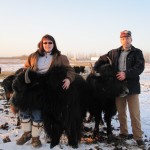The serious business of yak farming
March 28, 2011
907-474-5042
March 28, 2011

Passersby at the Kaspari farm outside Delta Junction inevitably slow down for a second, or third, look. The unusual creatures dotting the fields are yaks, and although they may look out of place in the Alaska countryside, they are perfectly suited to the environment.
“They fare very well here,” Phil Kaspari said. “They are hardy animals and they are efficient as far as feed consumption. They are easy keepers.”
Raising the critters for food and fiber, Phil and his wife Mary also intend to market them as pack animals.
Phil and Mary both grew up in Minnesota, with Phil’s summers spent working on his grandparents’ farm in North Dakota and Mary surrounded by horses. Phil earned a degree in agronomy at North Dakota State University then answered an ad for farm help with the Delta barley project. He settled into the Delta community and when the local Cooperative Extension Service agent retired he asked Phil to help out temporarily. That eventually turned into a regular job that has lasted 13 years so far.
All along Phil kept his own hand in farming, developing a hay business on rented ground. After Mary lost her first husband suddenly in North Carolina, the old friends reconnected and formed a life together. Phil admits Mary probably had hesitations about moving to Alaska, “but I didn’t want to move to North Carolina,” Phil said. “We had no idea whatever that we would be raising yaks.”
“Yaks were not on my list of life,” Mary said. “We are just trying to figure out what works.”
The couple married and bought property on Sawmill Creek Road, moving into a rental cabin until they could build a house. The landlord raised yaks and often the Kasparis tended them. Soon Mary, a registered nurse, was also helping market the meat. This proved easy for her because she believes strongly in the health benefits of yak meat. “It is lean meat and high in iron,” Mary said. “It’s good for people who are anemic and it has low cholesterol.”
The Kasparis compare the meat to beef that is somewhat sweet. “The burger is very good,” Phil said. Even the Buffalo Center Drive-in sells the burgers when there is enough meat.
Getting the animals to maturity takes about four years so patience is required in the process. Right now the Kasparis have 30 yaks and Phil hopes to grow the herd to 100. He is more enthusiastic about farming than Mary but both see the benefits. “I appreciate the self-employment part of it,” Phil said. “I like making decisions and managing the operations. I like to be outside and I appreciate the change in seasons, how the priorities change through the seasons.”
Even with all these advantages, there is also the fact that you have to put money into the infrastructure constantly. Phil is hoping to build a corral and squeeze chute to make handling easier and there is always a need for more fencing. Just about their only help comes from the youngest daughter, Grace, who is only 10 but helps when she can. Elise Baker is a student at the University of Alaska Fairbanks and Anne Baker-Bealer is in medical school in Missouri. Raising the yaks as well as horses has been good for the girls, Phil said. “It has helped Elise shine; she has a natural affinity for being around animals.”
The Kasparis raise 300 acres of hay for animal feed and grow a summer garden. “It is a lot to keep pursuing,” Phil said. “It’s a matter of how many hours are in a day.”

Mary’s outlook on farming is less optimistic. She explained it eats up a lot of time and money. With both Kasparis working full time it is challenging to fit in the farm chores and occasionally be up all night with calves. “We go round and round about whether it’s worth it,” Mary said. “Our whole summer is consumed with hay and then all winter long we haul hay.” Plus there are high fuel and fertilizer costs to contend with. “Phil says there is potential but I wonder where,” Mary said.
In spite of her hard take on the joys of farming Mary truly loves the animals. “I can be having a terrible week and go sit with Douglas (one of her favorite yaks) and it brings me back to center,” she said.
“I am very content around the animals. I don’t need to go on vacation; I’ve got heaven on earth right here.”
------------------
This column is provided as a service by the UAF School of Natural Resources and Agricultural Sciences and the Agricultural and Forestry Experiment Station. Nancy Tarnai is the school and station’s public information officer. She can be reached at ntarnai@alaska.edu.


